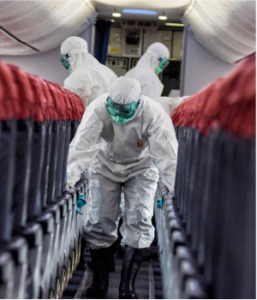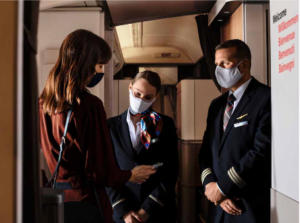Airplanes, with enclosed spaces and close quarters, have always given germ-conscious travelers reason to worry. When the World Health Organization identified SARS-CoV-2 novel coronavirus as a public health concern in January 2020 followed by officially declaring COVID-19 a pandemic two months later, the cleaning practices of airlines took center stage in the consciousness of travelers. Since that time airlines and public health officials worked tirelessly to adjust protocols and techniques to provide safe environments for passengers and crew to ensure air travel remains safe and enjoyable.
The travel industry has been one of the hardest hit by the coronavirus pandemic. During the early days of this global crisis, air travel dropped drastically, especially as travel bans and restrictions impacted tourism. Concerns of both passengers and flight crews prompted airlines to adopt more stringent safety protocols. Many of these new policies were guided by the Centers for Disease Control and Prevention, and some were developed by the airlines themselves as added measures to keep employees and passengers as safe as possible.
These new protocols often include multilayer sanitation procedures that involve more frequent cleaning of surfaces. Pre-COVID cleaning techniques often consisted of removing cabin trash in between flights, with a thorough cleaning only after a plane had finished its daily run. Current techniques are much more detailed, with all surfaces disinfected as often as possible including seats, armrests, tray tables and touchscreens. Lavatories and galleys get special attention, as do overhead bins. In addition to these improved cleaning practices, stronger disinfectant solutions, the use of personal protective equipment and advanced cleaning techniques make the risk of exposure to germs and viruses in an aircraft very low.
One new technique making huge advancements in quickly and thoroughly cleaning passenger and crew areas in between flights is the electrostatic spraying of the entire cabin. Air Canada, one of the first airlines to require passengers to wear face coverings in flight, adopted this method as part of the Air Canada CleanCare+ program.
This simple and effective modern technique cleans the entire aircraft in a matter of minutes. Every surface of the interior of the cabin, including lavatories and flight deck, is sprayed with a fine mist. The mixture contains a disinfectant solution combined with air and then atomized by an electrode. Because this mist is electrostatically charged, it coats all surfaces including nooks and crannies that may otherwise be missed by hand.

PHOTO: © ANKS RACHMAN | DREAMSTIME.COM
Many airlines employ this technique after every landing along with additional cleanings at various times throughout flights. Air Canada, along with other major airlines, also upgraded its cleansing agents to hospital-grade disinfectants that fight germs and viruses, including coronavirus. American Airlines, for example, uses EPA List N-approved disinfectants in between flights to clean surfaces used by both passengers and cabin crew such as seats, touchscreens, galleys and lavatories. While this maintains a safe cabin during flight time, American Airlines further ensures cleanliness by putting each aircraft through a deep cleaning each night and an “ultra-clean” every 45 days. Swiss International Air Lines aircraft undergo similar procedures, with planes receiving an intensive cleaning with specialized disinfectant chemicals upon each arrival in Zürich or Geneva.
Emirates, always an industry leader when it comes to amenities, customer service and stress-free travel, sets itself apart in its quest to ensure a sense of safety and confidence in travelers. In addition to offering passengers masks and hand sanitizer, the airline includes enhanced cleaning procedures as part of its effort to maintain clean and safe aircraft cabins.
During all flights, passenger restrooms are cleaned and disinfected every 45 minutes, and each aircraft undergoes a thorough deep cleaning upon return to Dubai. Onboard comfort items such as mattresses, pillows, blankets and headphones are sterilized and hygienically sealed. Cutlery and cookware used to prepare all onboard meals are sterilized prior to each use, and menus are either announced or provided on single-use sheets to minimize the sharing of printed materials. Not only are all passengers (with the exception of very young children) required to wear masks during all flights, but cabin crew members are also fully equipped with PPE (masks, face shields and gloves) on most flights to minimize the risk of spreading germs and bacteria.
Perhaps the single-most important factor in aircraft cleanliness is the High Efficiency Particulates Air (HEPA) filters used on airplanes to keep the cabin air clean and sanitized. These systems have been used on aircraft since the 1980s and are key in maintaining clean, breathable air for everyone on board.
The process is simple: Fresh air is brought in from outside the aircraft, heated to a temperature high enough to kill viruses, then cooled and dispersed into the cabin. The cabin air refreshes through the filter an average of every three minutes to remove any circulating germs or viruses picked up from inside the cabin and then is directed through the cabin vertically. This minimizes air flow along the length of the cabin and keeps the air in a constant cycle of filtering.
Studies show this process cleans the cabin air with a 99.97 percent efficiency rate, equivalent to standards found in hospital operating rooms. In addition to eliminating microscopic bacteria and virus particles, HEPA filters help reduce airborne allergens such as dust and pollen, thus further enhancing the cleanliness of aircraft cabins beyond the needs of the current global health crisis.
Along with more stringent and detailed cleaning techniques, many airlines also enacted additional measures that contribute to a cleaner and safer environment for both passengers and crew. Communal reading materials, such as newspapers and magazines, have been removed from most cabins to minimize shared surfaces and excess waste. Online apps offer a safer alternative, such as the PressReader app from British Airways, which offers 7,000 digital titles to keep passengers entertained and informed during flights. Most airlines perform in-flight safety tutorials via video; however, many that still provide written instructional cards for passengers, such as Emirates, thoroughly disinfect each card after each flight.

PHOTO: © SWISS INTERNATIONAL AIR LINES
As CDC guidelines require passengers on board airplanes to wear masks at all times except while eating, many airlines are making them available along with sanitizer and disinfectant wipes to help passengers stay and feel safe. British Airways, for example, provides passengers with “personal protection packs” that include disinfectant wipes, hand sanitizer and even a sealable bag for disposing of personal trash such as used face masks.
As public health concerns remain at the forefront of our everyday lives and affect our travel decisions, airlines continue to evolve polices and standards for aircraft cleanliness. Gone are the days when flight delays were the No. 1 concern of travelers. Today’s passengers are rightfully concerned with traveling in an aircraft that is clean and sanitary. Thankfully, airlines are meeting this challenge with safe and effective cleaning measures that keep us traveling safely despite the global challenges the industry faces.
Read This Next

Introducing
FX Excursions
FX Excursions offers the chance for once-in-a-lifetime experiences in destinations around the world.
#globility
Insta FeedCruises
May 17, 2025Viking Takes Delivery of Newest River Ship in Europe
Officially delivered March 18, Viking’s newest Longship Viking Nerthus was presented at Meyer’s Neptun Werft shipyard in Rostock Warneműnde, Germany. Accommodating up to 168 guests, Viking Nerthus spans 84 staterooms, all featuring Viking’s signature Scandinavian design.
Sponsored Content
Royal Air Maroc Introduces Groundbreaking Safety Video: A Captivating Invitation to Discover Moroccan Heritage
Royal Air Maroc continues to elevate the passenger experience with the launch of its new in-flight safety video — a cinematic journey that seamlessly blends essential safety instructions with a celebration of Moroccan cultural heritage.
Daily
May 16, 2025New Kosovo Philharmonic Opera, Ballet and Theatre Hall to Open This Year
A new opera and ballet theater in Kosovo will house four performance halls and a new public plaza in the capital city of Prishtina. As the first opera house in the Republic of Kosovo, the theater symbolizes the country’s rich and diverse cultural heritage while reflecting a new identity for Prishtina, rooted in creativity and a commitment to the country’s artistic growth.
Daily
May 16, 2025Inkaterra Hotels Make a Peru Trip Unforgettable
Looking to plan the ultimate trip to Peru, but not sure where to start? Inkaterra is here to help. With properties in multiple cities throughout the country and various immersive itineraries, Inkaterra makes it easy for your dream trip to Peru to come to life.
Sponsored Content
Sail Unique with Explora Journeys
SAIL UNIQUE: A New Chapter in Luxury Ocean Travel Imagine a place where modern European elegance meets the rhythm of the sea — where time slows down, and every detail is crafted to inspire connection and quiet indulgence. This is Explora Journeys, the luxury lifestyle ocean brand from MSC Group created to redefine how we explore the world.
Daily
May 16, 2025“Le Commandant Charcot” Will Complete Full Antarctica Circumnavigation in 2028
PONANT EXPLORATIONS will soon achieve a new world first when its Le Commandant Charcot will embark on a full circumnavigation of Antarctica, departing from Ushuaia, Argentina, from January to March 2028. This polar expedition unlike any before will journey nearly 11,200 miles of remote, uncharted coastline of the White Continent.
Culture Runs Deep in the Old Town of Corfu
May 2025
May 15, 20256 Unforgettable Dining Experiences Around the World
Daily
May 14, 2025eFlyer Reviews
May 14, 2025Hotel Van Zandt Review
One step onto Austin’s Rainey Street and you’ll feel like you’ve joined the cool kids at the best playground in the city. Just behind the cottage bars, pint-sized skyscrapers soar. One of them, Hotel Van Zandt, the Rainey district's pièce de resistance, beckons with a song-like spirit —apropos because the independently owned property, rife with music motifs, was named after beloved singer-songwriter Townes Van Zandt. Sixteen stories high, the hotel embodies Austin’s lust for music, manifesting with a vinyl corner; trumpet chandeliers; myriad musical references; replica vintage posters in frames; and its own live music venue, which doubles as its acclaimed restaurant, Geraldine’s. Don’t miss the mesmerizing installation of colorful origami-like birds composed from vinyl records that flitter from an old phonograph.
Sponsored Content
Find Your Perfect Escape with Paradisus by Meliá — More Than Just All-Inclusive
Luxury travel today is about more than just beautiful accommodations — it’s about experiencing the destination. Paradisus by Meliá takes traditional all-inclusive resorts to the next level by offering indulgence with immersion, experiences and authenticity. Each resort is shaped by its location, local flavors and curated Destination Inclusive® experiences that bring you closer to the heart of the destination.
eFlyer News
May 14, 2025National Geographic-Lindblad Expeditions Enters European River Cruise Market with 2026 Itineraries
National Geographic-Lindblad Expeditions recently announced its inaugural European river cruises, with bookings open for its 2026 sailings on May 20. Travelers can choose from two options, each focusing on different destinations and activities.
ShareThis